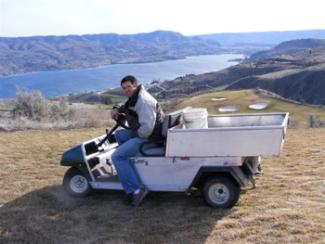Featured Golf News
Waking Up the Golf Course
For golfers in the northern tier of the U.S. one of the most anticipated days of the year is that magical calendar square that announces their favorite course has opened for the season. OK, there may be frost delays on the greens and frosty fingers getting there, but, by golly, it's time to golf.

Bear Mountain Superintendent Tim Fleegel
Here in North Central Washington that course for my compatriots and me is Bear Mountain Ranch, now open for its sixth season above the blue waters of fjord-like Lake Chelan, about 50 miles south of the Canadian border. The opening came three weeks early on March 12 due to a mild winter. This winter there was never more than 20 inches of snow on the ground, compared with the usual three to four feet. Additionally, there were few sub-zero or even single-digit temperatures.
For course superintendant Tim Fleegel, a 27-year-old Minnesota native and a member of the Golf Course Superintendents Association accustomed to hard winters, the tasks involved in getting his course in shape after the winter began last September. One of his first tasks is meeting with chemical and fertilizer reps and ordering the upcoming season's supplies to take advantage of an early order discount. The course plays 6,249 yards from the white tees, 6,761 from the blues and 7,231 from the tips. There are also bronze tees for seniors at 5,528 and the most forward red tees are 5,043 yards. This large spread of real estate requires nine tons of fertilizer.
The distribution of the additives begins in October with a dose of liquid fungicide on all 18 greens and the practice putting area. Fungicide is reapplied in the spring in amounts dependent in large measure on the extent of snow mold on the course's Putter variety of bentgrass.
Now back to late fall and winter: Reels on all the mowers are sharpened, bed knives are replaced when needed, and the eight utility carts are tended to - engines, tires and so forth. Throughout the off-season there are regular checks for ice beneath the snow - in a normal year the snowfall is deep enough to insulate the turf. This covering, measuring in feet all winter long, coupled with the heat from the Earth can produce a breeding place for molds in the micro-layer between the turf and bottom of the snow pack. "I walk a lot," notes Fleegel. "The extent of wetness and ice are all advisories of danger in the months to come."
Once the snow is gone the crew of three may be increased to its summer high of 13. But in the early pre-opening days physical work commences with blowing debris (mostly pine needles) off the greens. Unlike some other area courses, no snow blowers are employed to clear the greens. Once the ground is firm enough, tee markers are installed, divot boxes are placed on the four par-3 holes, pin locations are either marked or cut for the first time and, just before opening, the greens get their first mowing of the season at about 5/32nd of an inch. Sand is added to the bunkers, which are raked; the course's generous supply of rakes is placed by the traps.
The course is irrigated by a four-acre storage lake, whose water is pumped from Lake Chelan. The lake empties into a stream that comes into play on the 10th and 18th holes and is then re-circulated back to the lake. "I like to fire up the irrigation as late as I can," says Fleegel, "To take my time and give the lake at least four days to fill. If it fills slowly more air will bleed out of the system; fill it too fast and something will break."
All this activity is completed before the first customer tees off. In the beginning of the season, the superintendent works more than eight hours a day; come summer he is up at 4:30 every workday morning and commutes about 20 minutes from his home and family in Entiat, Wash.
Fleegel's philosophy: "Putting the course to bed properly makes it so much easier to awaken in the spring."
Bob Spiwak took up golf in 1953 as a respite from the rigors of selling bibles door-to-door in North Dakota. Though suffering a four-year lapse, he's back to being a fanatical golfer. Now a contributing editor for Cybergolf, Spiwak has written articles for almost every golf magazine in the Western world. Bob's most treasured golf antiquity is a nod he got from Gerald Ford at the 1990 Golf Summit. Spiwak lives in Mazama, Wash., with his wife and several pets next to his fabled ultra-private Whispering Rattlesnakes Golf & Flubbers Club.
Story Options
 |
Print this Story |
